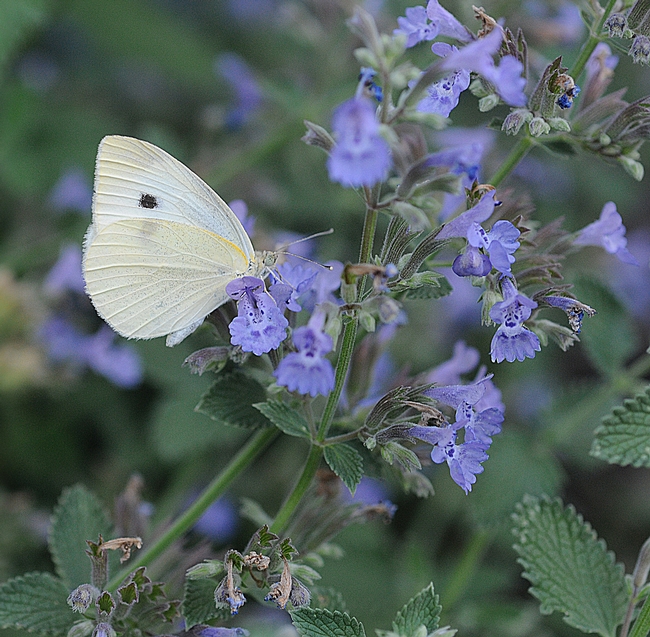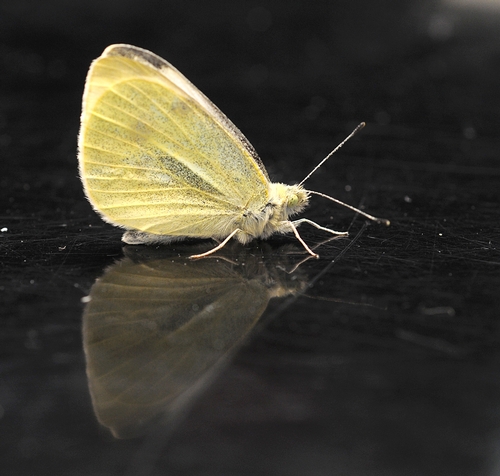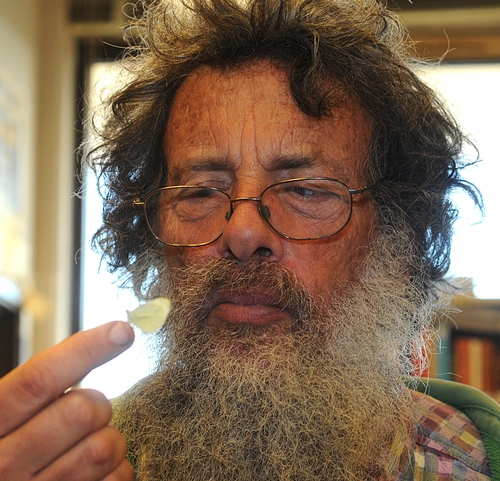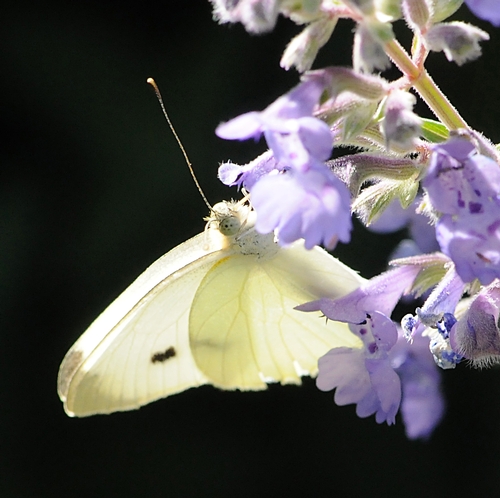- Author: Kathy Keatley Garvey
We've been waiting with bated breath for butterfly expert Art Shapiro, professor of evolution and ecology at UC Davis, to announce he's found the first Pieris rapae of the year.
Not so.
Not yet.
Every year since 1972 Shapiro has challenged the residents of Sacramento, Yolo and Solano to find the first cabbage white butterfly and bring it to him. First one to capture the butterfly in one of the three counties gets a pitcher of beer (or its cash equivalent).
Shapiro sponsors the annual contest to draw attention to Pieris rapae and its first flight. "I am doing long-term studies of butterfly life cycles and climate. Such studies are especially important to help us understand biological responses to climate change. The cabbage white is now emerging a week or so earlier on average than it did 30 years ago here."
Shapiro usually wins his own contest. He's lost only three times since 1972.
If you want to compete, be sure to check the rules.
Today he went a'hunting in West Sacramento. "What a grand and glorious April day it was!" he said. "Sixty-five degrees in West Sacramento, sunny, light and variable wind...a perfect day to get the first Pieris rapae of 2012. But I didn't. I spent 3-1/2 hours in West Sacramento checking every one of the more than 20 wild radish plants in bloom at least 3 times. If there had been a rapae there, I would have seen it! All I saw was two Vanessa annabella. The drama continues."
I looked through my Solano County photos of cabbage whites and noticed a two-at-a-time image, taken Sept. 7, 2008 in our backyard.
My camera, which can shoot eight frames a second, caught the images on the fly.
Art Shapiro can catch them with his hands. And does.

- Author: Kathy Keatley Garvey
Beer for a butterfly.
Now that's an interesting concept.
That’s what you’ll get—or the cash equivalent—if you collect the first cabbage white butterfly (Pieris rapae) of 2012 in an area encompassing Yolo, Solano or Sacramento counties.
Professor Art Shapiro of the UC Davis Department of Evolution and Ecology has issued the first call for his annual “Catch-a-Cabbage-White-Butterfly-Win-a-Pitcher-of-Beer” contest, which he launched in 1972.
The butterfly must be delivered live to the office of the Department of Evolution and Ecology, 2320 Storer Hall.
Since 1972 the first flight has varied from Jan.1 to Feb.22, averaging about Jan.20. The 2011 find was on Jan. 31.
Shapiro, a noted butterfly expert who maintains a website on butterflies, usually wins the contest. He caught the first cabbage white butterfly of 2011 at 1:21 p.m., Monday, Jan. 31 in Suisun City, Solano County.
The rules:
1. The butterfly must be captured in one of three California counties: Yolo, Solano or Sacramento on or after Jan. 1, 2012
2. It must be an adult (no caterpillars or pupae) and be captured outdoors.
3. It must be brought in alive to the department office, 2320 Storer Hall, UC Davis, during work hours, 8 a.m. to 5 p.m., Monday through Friday, with the full data (exact time, date and location of the capture) and your name, address, phone number and/or e-mail. The receptionist will certify that it is alive and refrigerate it. (If you collect it on a weekend or holiday, keep it in a refrigerator; do not freeze. A few days in the fridge will not harm it.
4. Other species are ineligible.
5. Professor Shapiro’s judgment is final. All butterflies submitted may be retained as vouchers.
The white butterfly, with black dots on the upperside (which may be faint or not visible in the early season), inhabits vacant lots, fields and gardens where its host plants, weedy mustards, grow. It is typically one of the first butterflies to emerge in late winter.
The male is white. The female is often slightly buffy; the "underside of the hindwing and apex of the forewing may be distinctly yellow and normally have a gray cast,” Shapiro says. “The black dots and apical spot on the upperside tend to be faint or even to disappear really early in the season.”
Shapiro sponsors the annual contest to draw attention to Pieris rapae and its first flight. "I am doing long-term studies of butterfly life cycles and climate. Such studies are especially important to help us understand biological responses to climate change. The cabbage white is now emerging a week or so earlier on average than it did 30 years ago here."
Shapiro, who is in the field more than 200 days a year, has been defeated only three times since 1972. And all were by his graduate students. Adam Porter defeated him in 1983; and Sherri Graves and Rick VanBuskirk each won in the late 1990s.
For more information, contact Art Shapiro at amshapiro@ucdavis.edu, (530) 752-2176.

- Author: Kathy Keatley Garvey
Nothing but net? No, no net.
We have a winner in the 40th annual Cabbage White Butterfly Competition, sponsored by butterfly expert Art Shapiro, professor of evolution and ecology at the University of California, Davis. Shapiro traditionally offers a pitcher of beer (or its equivalent) for the first cabbage white of the year collected in Yolo, Solano or Sacramento counties and delivered to the office of the Department of Evolution and Ecology, Storer Hall.
And the winner is...drum roll, please...Art Shapiro. Fact is, he's won the contest every year except for three.
And this year, he caught the prize-winner without a net.
Shapiro nabbed the first cabbage white butterfly (Pieris rapae) of 2011 at 1:21 p.m. today (Monday, Jan. 31) in Suisun City, Solano County. Last year he caught the first one on Jan. 27 in West Sacramento.
Although Suisun City is his oldest sampling site, dating back to 1972, Shapiro does not recall ever finding the first-of-the-year cabbage white there before. Precisely because of that, Shapiro traveled to Suisun at midday Monday without a net.
He saw it, a male, at 1:09 p.m. And he had no net.
“It was taking nectar from flowers of field mustard (Brassica kaber) along a 6-foot-high fence facing the sun,” Shapiro said. “I tried twice to catch it by hand but failed, and it soared over the fence into someone's back yard.”
"But I knew it wasn't as warm on the other side, and there probably wasn't anything in bloom either. So I figured I'd just wait and see if it came back. It did--and I got it on my first try."
Asked how he could catch an active butterfly by hand, Shapiro smiled and said "Experience." A few years ago he caught a very rare all-black mutant of the orange sulphur butterfly the same way.
Shapiro (see his website, http://butterfly.ucdavis.edu) sponsors the annual contest to draw attention to Pieris rapae and its first flight. "I am doing long-term studies of butterfly life cycles and climate," he said. "Such studies are especially important to help us understand biological responses to climate change. The cabbage white is now emerging a week or so earlier on average than it did 30 years ago here."
Shapiro, who is in the field more than 200 days a year, enlists public involvement "because I have that much more confidence that I am tracking the actual seasonality of this common 'bug.'"
Following his find, Shapiro said he took his disappointed grad students out for beer at The Graduate, a local pub, after work. “I usually buy the first pitcher anyway,” he said.
Shapiro has lost only three times in 40 years--and all by his graduate students. Adam Porter found the first cabbage white in 1983; and Sherri Graves and Rick VanBuskirk each claimed the title in the late 1990s.
Interestingly, people contact him as late as June asking if they’ve won.
“No,” he tells them. “Too late.”


- Author: Kathy Keatley Garvey
Especially when it nectars from catmint (Nepeta) in the early evening, as the sun drops low in the horizon.
Butterfly expert Art Shapiro, professor of ecology and evolution at the University of California, Davis, says the species was introduced in southern Canada in the 1850s. "The great lepidopterist Samuel H. Scudder traced its spread, but was unable to resolve the history on the West Coast," he writes on the website, Art's Butterfly World.
"It was not in San Francisco in the early 1880s, but was abundant by the time of the earthquake (1906)."
Just look at it now. It's everywhere. In fact, every year Shapiro sponsors a contest to see who can find the first cabbage white of the year in the Davis-Sacramento area.
He usually wins.


- Author: Kathy Keatley Garvey
The cabbage white butterfly (Pieris rapae) looks like a Lady in White when she perches on catmint.
The colors are striking: A long, flowing white gown nestled among the rich lavender blossoms and earthy green leaves.
UC Davis Butterfly expert Art Shapiro says this insect flies an average of 44 weeks of the year in the Davis-Sacramento area. It seems to particularly love the catmint in our garden.
Last night, however, it was flying in our kitchen.
There is no catmint in the kitchen.
There is only a cat.
The confused butterfly probably entered the kitchen through an open door--or the cat door.
My mission: Rescue the butterfly bouncing around in the kitchen and let it go before the cat, aka Xena the Warrior Princess, developed a culinary interest in it.
Mission accomplished.
Back to the catmint it went. I did not take it to Shapiro and ask "Did I win?"
You see, every year Shapiro sponsors a cabbage white contest in the Davis-Sacramento area. The first person who delivers a cabbage white to him, starting the first of the year, wins a pitcher of beer. The contest always ends in January or February.
"Almost every year," he says, "someone brings one in May or June and asks 'Did I win?'"
No losers this time, though. The Lady in White won.
She won the how-to-get-out-of-the-kitchen-unscathed-and-back-to-the-catmint contest.




